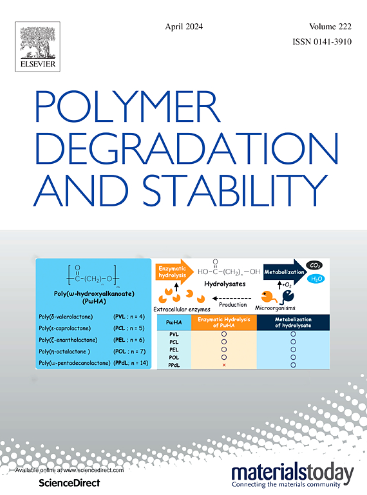提高阻燃性的固态改性
IF 6.3
2区 化学
Q1 POLYMER SCIENCE
引用次数: 0
摘要
欧盟关于卤化阻燃剂的规定导致了对替代品的调查。聚对苯二甲酸丁二酯(PBT)因其在电气和电子应用方面的诱人性能而被广泛使用,是这些指导方针下面临风险的聚合物之一。事实上,其较差的耐火性往往限制了其使用或需要添加潜在的有毒元素。因此,改善其可燃性是至关重要的,而固态改性(SSM)是在保持其晶体结构和热机械特性的同时实现这一目标的理想方法。因此,利用生物基共单体制备了由SSM制成的膨胀型共聚酯。首先,用碳化剂2,3:4,5-二- o -异丙基半乳糖酸酯(GalX)对PBT进行改性。这一过程的优化包括温度、时间和压力的影响研究。P(BT-co-GalXT)的热性能表明,PBT的正极性质被保留,反映了固态反应中结晶相的保存。最后,纯PBT可以与共聚酯和聚磷酸铵结合,得到在UL 94测试中达到V-0等级的膨胀体系。该组合物显示了均聚物的理想性能以及改进的防火性能。本文章由计算机程序翻译,如有差异,请以英文原文为准。

Solid-state modification for improved flame retardancy
The European Union's regulations on halogenated flame retardants have led to investigations of alternatives. Poly(butylene terephthalate) (PBT), commonly used for its attractive properties in terms of use in electrical and electronics applications, is one of the polymers at risk under these guidelines. Indeed, its poor fire resistance often restricts its use or requires the addition of potentially toxic elements. The improvement of its flammability properties is thus crucial, and solid-state modification (SSM) is an ideal method to achieve this while preserving its crystalline structure and thermomechanical characteristics. Therefore, an intumescent copolyester made by SSM using a biobased co-monomer has been prepared. First, PBT was modified with a carbonizing agent, 2,3:4,5-di-O-isopropylidene-galactarate (GalX). The optimization of this process involved study of the effects of temperature, time, and pressure. The thermal properties of P(BT-co-GalXT) demonstrates that the positive qualities of PBT are retained reflecting the preservation of the crystalline phases during the solid-state reactions. Finally, pure PBT may be combined with the copolyester and ammonium polyphosphate to obtain an intumescence system which exhibits V-0 rating in the UL 94 test. This composition displays the desirable properties of the homopolymer as well as improved fire behavior.
求助全文
通过发布文献求助,成功后即可免费获取论文全文。
去求助
来源期刊

Polymer Degradation and Stability
化学-高分子科学
CiteScore
10.10
自引率
10.20%
发文量
325
审稿时长
23 days
期刊介绍:
Polymer Degradation and Stability deals with the degradation reactions and their control which are a major preoccupation of practitioners of the many and diverse aspects of modern polymer technology.
Deteriorative reactions occur during processing, when polymers are subjected to heat, oxygen and mechanical stress, and during the useful life of the materials when oxygen and sunlight are the most important degradative agencies. In more specialised applications, degradation may be induced by high energy radiation, ozone, atmospheric pollutants, mechanical stress, biological action, hydrolysis and many other influences. The mechanisms of these reactions and stabilisation processes must be understood if the technology and application of polymers are to continue to advance. The reporting of investigations of this kind is therefore a major function of this journal.
However there are also new developments in polymer technology in which degradation processes find positive applications. For example, photodegradable plastics are now available, the recycling of polymeric products will become increasingly important, degradation and combustion studies are involved in the definition of the fire hazards which are associated with polymeric materials and the microelectronics industry is vitally dependent upon polymer degradation in the manufacture of its circuitry. Polymer properties may also be improved by processes like curing and grafting, the chemistry of which can be closely related to that which causes physical deterioration in other circumstances.
 求助内容:
求助内容: 应助结果提醒方式:
应助结果提醒方式:


